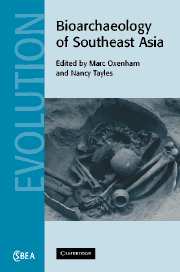Book contents
- Frontmatter
- Contents
- List of contributors
- Foreword: Emerging frontiers in the bioarchaeology of Southeast Asia
- Preface
- 1 Introduction: Southeast Asian bioarchaeology past and present
- Part I Morphological diversity, evolution and population relationships
- 2 The population history of Southeast Asia viewed from morphometric analyses of human skeletal and dental remains
- 3 A multivariate craniometric study of the prehistoric and modern inhabitants of Southeast Asia, East Asia and surrounding regions: a human kaleidoscope?
- 4 Interpretation of craniofacial variation and diversification of East and Southeast Asians
- 5 New perspectives on the peopling of Southeast and East Asia during the late upper Pleistocene
- 6 Human variation and evolution in Holocene Peninsular Malaysia
- 7 Dentition of the Batak people of Palawan Island, the Philippines: Southeast Asian Negrito origins
- Part II Health, disease and quality of life
- Part III Conclusions
- Index
- References
6 - Human variation and evolution in Holocene Peninsular Malaysia
Published online by Cambridge University Press: 18 November 2009
- Frontmatter
- Contents
- List of contributors
- Foreword: Emerging frontiers in the bioarchaeology of Southeast Asia
- Preface
- 1 Introduction: Southeast Asian bioarchaeology past and present
- Part I Morphological diversity, evolution and population relationships
- 2 The population history of Southeast Asia viewed from morphometric analyses of human skeletal and dental remains
- 3 A multivariate craniometric study of the prehistoric and modern inhabitants of Southeast Asia, East Asia and surrounding regions: a human kaleidoscope?
- 4 Interpretation of craniofacial variation and diversification of East and Southeast Asians
- 5 New perspectives on the peopling of Southeast and East Asia during the late upper Pleistocene
- 6 Human variation and evolution in Holocene Peninsular Malaysia
- 7 Dentition of the Batak people of Palawan Island, the Philippines: Southeast Asian Negrito origins
- Part II Health, disease and quality of life
- Part III Conclusions
- Index
- References
Summary
Introduction
Peninsular Malaysia is home to four groups recognised by the Malaysian government as bumi putra or ‘children of the soil’. These are the mainstream Melayu Malays, who became the dominant occupants after the declaration of the sultanate of Melaka in the early fifteenth century, and three ‘Orang Asli’ aboriginal groups, which each include several tribes (Benjamin 2002). Experts agree on the classification of the Orang Asli into three groups, although opinion varies on how these groups arose and why their distinctions can be ambiguous (Rashid 1995, Fix 2002). Best known but least numerous are the Semang Negritos, rainforest foragers characterised by dark skin, woolly hair and, at least until recent decades, short stature (Bulbeck 2004). They have all now been resettled except for one group of Batek, who traverse the Taman Negara National Park and combine paid work as guides with traditional foraging and desultory agriculture in the form of replanting tubers (Tuck Po 2000). The most numerous Orang Asli are the Senoi, especially the Semai and Temiar, who, until recent times, subsisted through swidden farming in remote forest tracts. Skin colour tends to be light; hair form is highly variable, while stature and body build are slight (Fix 2002). The so-called Aboriginal Malays distinguish themselves from Melayu Malays mainly through their tardy uptake of Islam and other Malay cultural trademarks, and their aptitude in collecting forest produce for trade (Benjamin 1985).
- Type
- Chapter
- Information
- Bioarchaeology of Southeast Asia , pp. 133 - 171Publisher: Cambridge University PressPrint publication year: 2006
References
- 6
- Cited by



